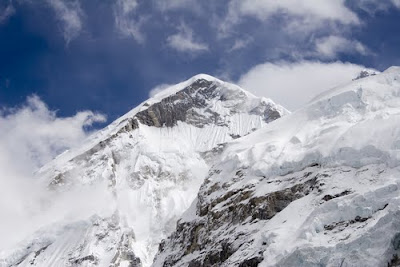



Sagarmāthā National Park is a protected area in the Himalayas of eastern Nepal containing the southern half of Mount Everest. The park was created on July 19, 1976 and was inscribed as a Natural World Heritage Site in 1979. Sagarmāthā is a Sanskrit word, from sagar = "sky" (not to be confused with "sea/ocean") and māthā = "forehead" or "head", and is the modern Nepali name for Mount Everest.
The park encompasses an area of 1,148 km2 in the Solukhumbu District and ranges in elevation from 2,845 metres (9,334 ft) at Jorsalle to 8,848 metres (29,029 ft) at the summit of Mount Everest. Barren land above 5,000 m (16,400 ft) comprises 69% of the park while 28% is grazing land and the remaining 3% is forested. Most of the park area is very rugged and steep, with its terrain cut by deep rivers and glaciers. Unlike other parks, this park can be divided into four climate zones because of the rising altitude. The climatic zones include a forested lower zone, a zone of alpine scrub, the upper alpine zone which includes upper limit of vegetation growth, and the Arctic zone where no plants can grow. The types of plants and animals that are found in the park depend on the altitude. The park contains the upper watershed of the Dudh Kosi river basin system.
The park's visitor centre is located at the top of a hill in Namche Bazaar, also where a company of the Nepal Army is stationed for protecting the park. The park's southern entrance is a few hundred metres north of Monzo at 2,835 m (9,300 ft), a one day hike from Lukla.
Source ; Wikipedia.com

No comments:
Post a Comment